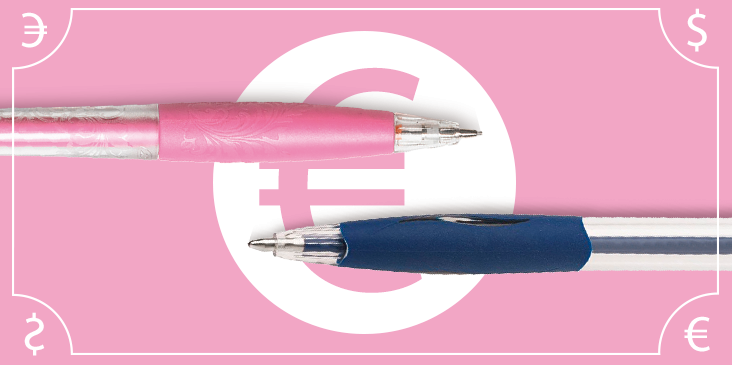
Gender identification and price discrimination among men and women are very controversial issues.
In December 2015, a study by the New York City Department of Consumer Affairs was released stating that women pay on average 7% more than men; this is known as the “pink tax.” However, they also found that men pay more for some products and services as well. Why does gender pricing exist, and why do brands market products by gender to consumers? Let’s examine gender pricing and why it is a valuable marketing tool to utilize in order to implement value to consumers.

From a consumer perspective, it is easy to get angry at these big businesses for taking advantage of consumers by making them pay different prices based on their gender. But from the business perspective, it is easy to embrace the idea that some consumers are willing to pay more than others. It is how some of the most successful companies on the market are bringing in their revenue. Large American discount retailers such as Walmart, Target, and Kroger all sell their products at different prices for men and women. Some people may question how this works. What if the consumers choose not to buy the higher priced products, and buy the products made for the opposite gender? Then they wouldn’t even be on shelves. The product would be discontinued. But these products are in fact still on shelves. No man wants to smell like a woman, so they will pay a different price for body wash and soaps than women. No woman wants to smell like a man, so instead they will pay the extra 30 cents to use deodorant designed for women. Imagine one Walmart store with the exact same deodorant stick but one was labeled for men and one was labeled for women. This store sells 1,000 units of men’s deodorant priced at $2.89 in a week and another 1,000 units of women’s deodorant priced at $3.19 the same week. That’s a total of $6,080! If they were sold at the same price, the total would only amount to $5,780. Factor in all the costs of production and transportation, and that extra $300 really makes a difference. After a whole year of selling 2,000 of these products a week at the prices set earlier, that brings in an extra $15,600. And that’s only by gender pricing one product. Imagine gender pricing thousands of products in a store. Revenue is in the millions, perhaps even more for the retailers that see a higher conversion rate than 2,000 units a week in deodorant. Apart from just making money, retailers do have extra costs to account for, especially in women’s products, where the price differences are most noticeable: the few extra cents it costs to add in pink or make the scents in products, more money to tailor the clothes to a woman’s body, and more advertising of women’s products.
So, why are so many people getting upset about gender pricing? Is it immoral? There are a lot of things in life that are immoral. American presidential candidate Donald Trump, for example, takes immoral to the hilt, degrading women, blasting other candidates and making fun of a disabled reporter. Yet he still has 86% of the Republican votes and is the only Republican candidate in the running. He is also a billionaire. It’s hard to imagine that he got to this point in his life by doing things by the book? Heck no. And yet he is the proud owner of The Trump Organization and hundreds of other businesses, trademarks, shows, books, and properties. Trump is, first and foremost, a successful businessman. He has a solid brand image and is obviously employing an exceptional PR approach in his presidential campaign. Trump has undoubtedly developed a formula for success that other entrepreneurs and CEO’s will be looking at closely in the future. Hiking up the prices a little bit on women’s clothing here and on men’s manicures there is one way to do this. Even though consumers can see the obvious price discrepancy, they will still pay more because they have no other choice; much like how even though so many Americans believe there is so much morally wrong with Donald Trump, he is still delivering the value that the people of America are craving. As long as there is a perceived amount of value in the products or services, consumers will be more inclined to pay whatever the price is to receive that value.
Calvin Harris, a popular DJ in the music industry, has come into the spotlight recently for charging men and women different prices for tickets to his concert at a Los Vegas nightclub. However, according to Matt Colon, co-founder of Deckstar Management and manager for Steve Aoki, another famous DJ, the performers have no say in the pricing of tickets. It is solely up to the nightclub to determine prices, and many venues on the Las Vegas Strip sell tickets to women much cheaper than the price they sell to men. At Harris’ concert, women’s tickets are just $40, while men’s tickets are $100. It is the same tactic that is used at other nightclubs or bars – women get in free or for a discounted price, while men end up paying more. The theory behind this is that when men see signs that indicate women get in free, men will be more inclined to go to that establishment because there will be a much larger selection of women there than on any other night or at any other club. Men are willing to pay extra so they can dance with as many women as they want. Women are willing to pay less because it will make them feel special, especially after seeing how much men have to pay to get in. Bars and nightclubs make enormous profits this way.
Let’s assume that 500 men attend the Calvin Harris show, for a total of $50,000. Then let’s say twice as many women attend because the tickets are cheaper. That’s $40,000, for total combined revenue of $90,000. Now let’s look at how much revenue would be made if tickets were sold at the same price of $100. Less people are willing to pay this much for a ticket, so we’ll assume that only about 700 people would buy the tickets. That’s $70,000; $20,000 less than what could have been made and 800 less people who will buy food and drinks or recommend the club to a friend later. Word of mouth is one of the most important, easiest, and cheapest ways to advertise a business. So if you could bring in 800 more people and an additional $20,000 for your business, wouldn’t you do it too?
The main takeaway from this is not to look down on gender pricing as a derogatory or sexist term. Gender pricing, or even more broadly, price discrimination or dynamic pricing, is simply a helpful marketing and business strategy that is becoming more essential in today growingly competitive environment. It is not even limited to products on shelves or concert tickets; there is price discrimination even in college tuition, with in-state residents paying lower tuition rates than out of state, or minorities paying less or receiving more scholarships. Senior citizens also pay less for many products and services.
While some may view it as unethical or just plain wrong, you have to look at it as part of the bigger picture: Donald Trump’s actions may make him seem immoral to many but he is still a very successful businessman and his chances of becoming the next president of the United States are increasing day by day. People may disagree with his behavior but they respect him in the sense that he has built his own empire, and feel that he will provide utilitarian value to the American government. Patrons at nightclubs in Las Vegas may also disagree with the price of their tickets, but they still buy them nonetheless, because the services provide hedonic value to them. As long as the products and services are providing the right value to the right customers, companies should feel free to price them however they desire – within reason, of course.